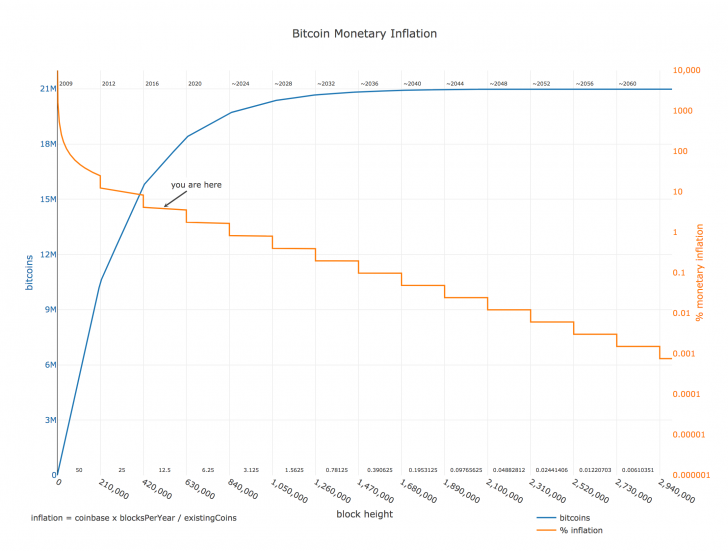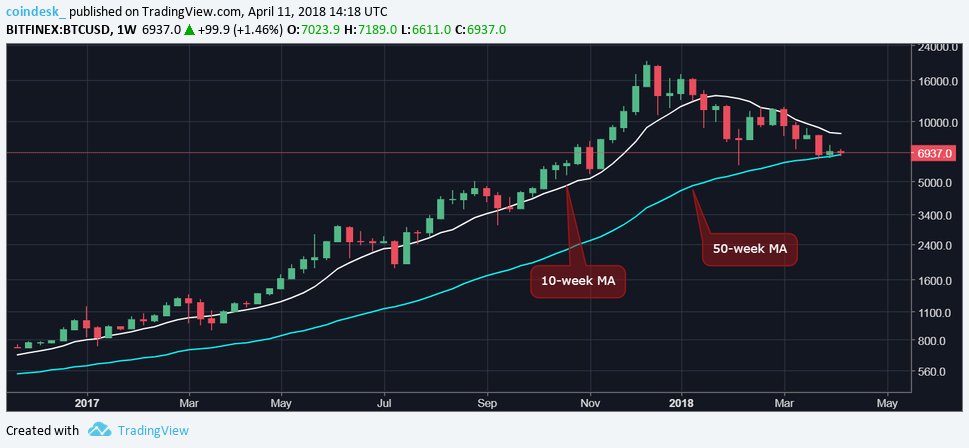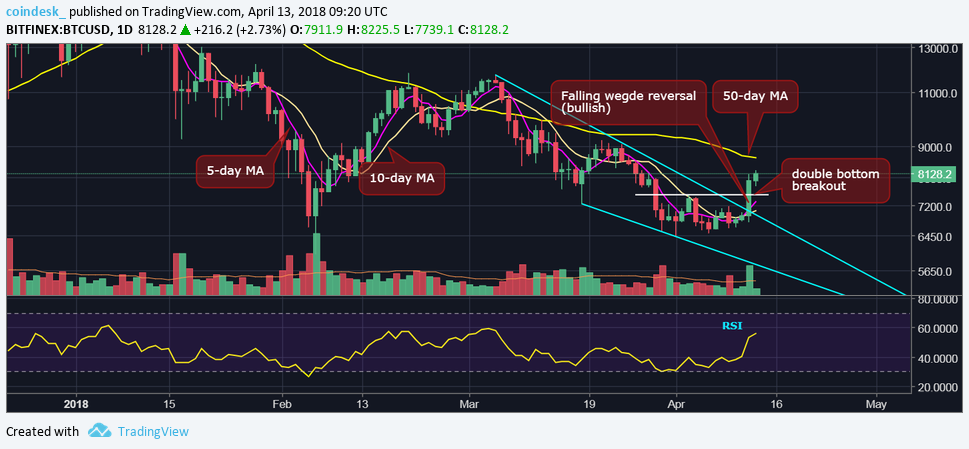 Bitcoin's limited supply is about to get a bit more limited. Barring an unforeseen event, the 17 millionth bitcoin is likely to be mined in the coming day, data from Blockchain.info shows, a development that would mark yet another milestone for the world's first cryptocurrency. That's because as per bitcoin's current rules, only 21 million bitcoin can ever be created. Stepping back, the milestone, the first million-bitcoin marker to be crossed since mid-2016, is perhaps noteworthy as yet another reminder of the technology's core computer science achievement - digital scarcity created and enabled by shared software. In short, bitcoin's code, since cloned and adapted by scores of other upstart cryptocurrencies, ensures that only a set number of new bitcoins are introduced to its economy at intervals. Miners, or those who operate the hardware necessary to track bitcoin's transaction set, are rewarded with this scarce data every time they add new entries to the official record. Still, there's a lot of variability in the process. Of note is that it can't be precisely predicted when the 17 millionth bitcoin will be mined or who will mine it, due to the many minute variances that are created in keeping a common software in sync. That said, there's a relative predictability. Each bitcoin block produces 12.5 new bitcoin, and as bitcoin blocks occur roughly every 10 minutes, about 1,800 new bitcoin are created each day. As such, it's perhaps best to view this event as a "psychological barrier," Tetras Capital founding partner Alex Sunnarborg told CoinDesk, one that is interpreted differently by different communities. Sunnarborg, for example, sought to stress that another way to interpret the result is that 80 percent of all the bitcoin that will be ever created have now been mined. In other words, only about one-fifth of the eventual supply remains for miners and future buyers. Others see the milestone as one that's ripe for appreciation of the technology and its achievements. "I think it is awesome," Tim Draper, the venture capitalist who bought millions of dollars worth of bitcoin seized by the U.S. government at auction in 2014, said of the coming milestone. He told CoinDesk: "I would bet the founders wouldn't have imagined how important bitcoin would become in their wildest dreams." Way with wordsOthers sought to suggest the milestone is one that should be considered as an opportunity for education about both the features of bitcoin, and those of cryptocurrencies broadly. For example, unless all of the humans who operate the computers running the bitcoin software decide to make a change (a perhaps unlikely scenario today), there's really no way to ever introduce more new bitcoin. This achievement, a technical reality, has played a key role in bitcoin's association with money, economics and other scarce, naturally occurring assets. In this way, the goldbugs and readers of Austrian economics who piled into bitcoin early on were quick to realize the value of the feature, perhaps giving rise to the term "cryptocurrency" itself. Trace Mayer, one of this group's most vocal members, summed up the philosophy in a recent tweet, in which he argued governments might seek to prevent users from holding bitcoin in the future. "Increasing money supply is a means to confiscate through inflation which is a form of taxation without representation or due process of law," he wrote. Even the new way new bitcoins come into being, called "mining," is a nod to the gold analogy. Rather than being issued by a central bank, bitcoin is created by a network through the work of maintaining the blockchain. When a miner finds a valid hash for recent transactions, solving the bitcoin protocol's puzzle, he or she is rewarded with a "coinbase transaction," bitcoin credited to her account. A little bit of cryptocurrency is created and deducted from the final supply. The bitcoin supply curveHow participants have been rewarded has, of course, changed over time. When bitcoin's founder Satoshi Nakamoto mined the first bitcoin block on Jan. 3, 2009, he created the first 50 bitcoins. This reward stayed the same for another 209,999 blocks, when the first "halvening," or reduction in rewards, took place. It didn't come as a surprise. Every 210,000 blocks, according to a hard-coded schedule, the network reduces the block reward by 50 percent. Following the most recent halvening, in July 2016, the reward is 12.5 bitcoin. That means that while there are only 4 million bitcoin left to mine, the network will not reach its final supply in anything like the nine years it's taken to get this far. As the halvenings halven, the rate of monetary inflation - supply growth - slows. BashCo, a pseudonymous moderator on the r/bitcoin subreddit, has plotted the trajectory of bitcoin's total supply (blue curve) against its rate of monetary inflation (orange line). Source: BashCo. Assuming the bitcoin protocol remains the same (a new block is mined every 10 minutes on average and the halving schedule and supply cap are unchanged), the last new bitcoin will not be mined until May 2140. The next 120 yearsWith this in mind, the chart hints at another common talking point when acknowledging the milestone - that bitcoin is programmed to run for a very long time. Jameson Lopp, lead infrastructure engineer at wallet provider Casa, was quick to remind CoinDesk that bitcoins are divisible, and that as such, the smallest parts of each bitcoin can hold seemingly infinite value. He said: "While 17 million BTC may sound like a lot, it's incredibly scarce - there won't even be enough for every current millionaire to own a whole bitcoin. Thankfully, each bitcoin is divisible into 100 million satoshis, thus there will always be plenty to go around!" But there are other quirks to the software as well. For one, bitcoin will never actually reach 21 million units, as barring a protocol change, the total supply will fall short by at least one satoshi. That's because on May 17, 2011, the miner "midnightmagic" - for reasons that remain unlear - claimed a 49.99999999 block reward, rather than an even 50. Further, to be clear, bitcoin does not stop running when 21 million bitcoin are produced. At that point, the idea is that miners would be compensated purely through the fees, which they already collect. (Though some scientists have sought to project whether such a market would work in practice). With so many questions left unanswered, if anything, the event serves as yet another reminder of how far bitcoin has come, and just how far it has to go. In the words of long-time developer Adam Back: "Another million down four more to go."
0 Comments
Bitcoin (BTC) clocked a 2.5-week high of $8,225 on Bitfinex earlier today and could soon scale the $8,500 mark, the technical charts indicate.
Prices jumped close to 14 percent on Thursday and moved above the $8,000 mark for the first time since March, according to Bitfinex. The sharp rally was reportedly fueled by the unwinding of the short trades (also known as short liquidation). Moreover, BTC margin shorts (sell BTC trades) on Bitfinex stood well above December highs. As such, there was always a risk of short liquidation and bitcoin price rise. That said, the margin longs (buy BTC) registered a decline as well, thus putting a question mark on the sustainability of gains. However, volume analysis suggests the rally is here to stay. The total trading volume across all exchanges jumped above $8 billion yesterday, according to CoinMarketCap. Also, the trading volume on Bitfinex hit a two-week high. Further, the price chart analysis indicates a short-term bearish-to-bullish trend change, so, the cryptocurrency looks set to extend the rally. As of writing, bitcoin is changing hands at $8,100 on Bitfinex - up 18 percent on a 24-hour basis. BTC closed yesterday above $7,500, confirming a double bottom bullish breakout and the falling wedge reversal (bullish pattern). The breakout was also backed by strong volumes. Momentum studies show a 5-day moving average (MA) and 10-day MA trending north, indicating bullish setup. The relative strength index (RSI) has moved above 50.00 (into the bullish territory). So, the tide has turned in favor of the bulls, at least for the short-term. View
 The second quarter of 2018 may bring some respite for beleaguered bitcoin (BTC) bulls. The world's largest cryptocurrency by market valuation seems to have found a bottom around the $6,500 mark, having dropped 50 percent in the first quarter - notably, the worst Q1 performance on record. Overall, its safe to say bulls have been struggling to find their feet as indicated by stagnant prices and a narrowing price range. Yet, speculation is doing the rounds that big Wall Street names (such as Soros and Rockefeller) are set to enter the crypto space. If confirmed, the news could ramp up the bull case, as happened with the advent of bitcoin futures soon before bitcoin's December price peak. However, history may be on bitcoin's side as well - an analysis of the CoinDesk Bitcoin Price Index shows BTC tends to perform well in the second quarter.
Further, the bullish argument put forward by historical data adds credence to CoinDesk's view that the much-feared "death cross" (50-day and 200-day moving average (MA) bearish crossover) could be a "bear trap." Additionally, the weekly chart does show a potential for a minor corrective rally. Weekly chart The above chart (prices as per Bitfinex) shows, for the third straight week, the ascending 50-week MA is capping the downside in BTC. This, coupled with the basing pattern around $6,500, as seen on the daily chart (not shown), indicates that bitcoin could soon test resistance lined up around $7,500. A convincing move above $7,500 could yield a rally to the descending (bear-biased) 10-week MA, currently located at $8,605. However, in the larger scheme of things, only a close above $11,700 would signal a bearish-to-bullish trend change. BTCBitcoin (BTC) fell below the $7,000 mark on Wednesday, neutralizing the immediate bullish outlook.
More worryingly for the bulls, a further decline towards $6,425 (recent low) would turn the tide in favor of the bears, the technical charts indicate. The cryptocurrency witnessed a head-and-shoulders breakdown at 09:00 UTC yesterday and fell to $7,000 (target as per the measured height method). The hourly momentum studies (moving averages) were aligned for a bullish move at the time, hence BTC was expected to defend the psychological mark. However, the sell-off gathered pace early in the U.S. session, pushing BTC down to a low of $6,670, according to Bitfinex data. Interestingly, the drop in BTC prices coincided with a 500 point sell-off in S&P 500 futures. Since late February, bitcoin and U.S. stocks have been moving more or less in tandem, indicating the cryptocurrency is still being perceived as a risk asset. By the day's end, U.S. stocks had turned positive, yet bitcoin fell further to $6,565 in the Asian hours before regaining some poise. As of writing, BTC is changing hands at $6,847 on Bitfinex. While the retreat to $6,565 has turned the tide away from the bulls, all is not lost. A close today (as per UTC) above the 10-day moving average would still boost the odds of an upside break of the falling channel (seen chart below). Daily chart The 5-day moving average (MA) is flatlined (neutral) and the 10-day MA is biased to the bears (sloping downwards). A close above the 10-day MA, currently seen at $7,148, would signal the sell-off from $11,700 (March 5 high) has ended at $6,425 (April 1 low) and will likely yield a bullish falling channel breakout. The channel resistance is seen sloping downwards to $6,600 in the next 24 hours. An upside break of the falling channel would confirm the short-term bullish trend reversal. View
|





 RSS Feed
RSS Feed
